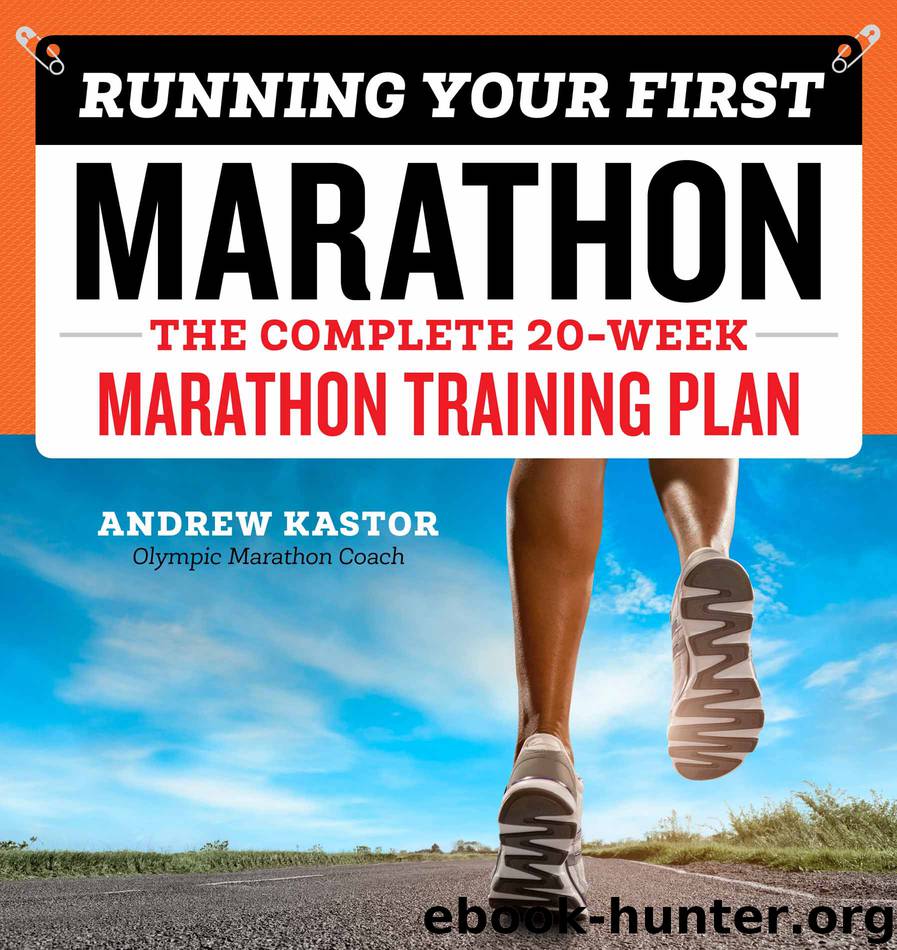Running Your First Marathon by Andrew Kastor

Author:Andrew Kastor
Language: eng
Format: epub, mobi
Publisher: Rockridge Press
Published: 2018-01-13T05:00:00+00:00
BE PATIENT
Marathon runners are highly motivated athletes, in general, and usually have high pain tolerances. They’re always tempted to hop right back in where they left off with their training, despite an injury and all its setbacks. But once the pain has subsided, a full range of motion has been restored in all your joints, and there’s no noticeable swelling in the area, it is okay for you to consider resuming your training. This return should be a mindful, gentle process.
If need be, consider walking as an alternative to running for the first couple of days you feel like going for a run again. The most important thing is that you’re back out there doing it. And when that first training run finally arrives, put on a smile. Venturing out for a run should be an absolute joy. The first week back should be at an easy effort, completing a total distance that’s only about 30% of the last full training week you finished before getting sidelined. From there, add 10% each week for about four to six weeks. At that point, if you’re still feeling healthy, you can resume full training with prescribed workouts and long runs.
BE GOOD TO YOUR BODY
I always advise runners to pamper and take special care of themselves during marathon training. Doing little things throughout the day to make yourself feel better, more rested, and recovered can help make training easier and enjoyable. Sit down at every opportunity you get; get off your feet and allow your legs to rest when you’re not training.
Great Ways to Pamper Yourself for Better Results
Get at least eight hours of sleep every night. While we sleep, our bodies produce hormones that work overtime to repair themselves from the stress of training and life. When we don’t get enough sleep, our bodies produce hormones, like cortisol, that can cause negative effects instead. Marathon runners are stressing each of their bodily systems, exhausting their energy reserves, depleting their growth hormones, and damaging tissues on a regular basis. This is above and beyond the “normal” daily activities of other folks. One or two 20- to 40-minute naps a week help with the recovery process.
Apply the rule of RICE periodically. RICE is a mnemonic for Rest, Ice, Compression, and Elevation. The rules are simple to follow for treating a soft-tissue injury, such as a sprained ankle or a strained calf.
•Rest. Take a day or two off when soreness is first felt.
•Apply ice to the area that’s sore for about 10 to 12 minutes at a time, and be sure to wait one hour before applying ice again.
•Practice compression. With an elastic bandage, wrap the injury firmly, but loose enough to permit free motion. This reduces swelling and promotes blood flow.
•Elevate your injured area above the heart for 15 to 20 minutes, several times a day, to help reduce swelling.
Try cryotherapy, or soaking in cold baths, as a great way to recover from a hard workout or long run. During the summer months here
Download
This site does not store any files on its server. We only index and link to content provided by other sites. Please contact the content providers to delete copyright contents if any and email us, we'll remove relevant links or contents immediately.
Going Long by Editors of Runner's World(1920)
The Happy Runner by David Roche(1818)
Yoga For Dummies by Georg Feuerstein(1204)
Legacy by Kerr James(1054)
Becoming Boston Strong by Amy Noelle Roe(1022)
Winger by Smith Andrew(996)
The Little Red Book of Running by Scott Douglas(883)
Bowerman and the Men of Oregon by Kenny Moore(882)
Wodehouse At the Wicket by P.G. Wodehouse(862)
5050 by Dean Karnazes(838)
The Way of the Runner by Adharanand Finn(834)
Swim, Bike, Run - Eat by Tom Holland(828)
Running Your First Marathon by Andrew Kastor(828)
The Coming Storm by Nigel McCrery(777)
Spiked (Blocked Book 3) by Jennifer Lane(771)
Blade Runner by Oscar Pistorius(752)
The Shared Origins of Football, Rugby, and Soccer by Christopher Rowley(748)
The Amazing Test Match Crime by Adrian Alington(747)
The Grade Cricketer by Dave Edwards(745)
